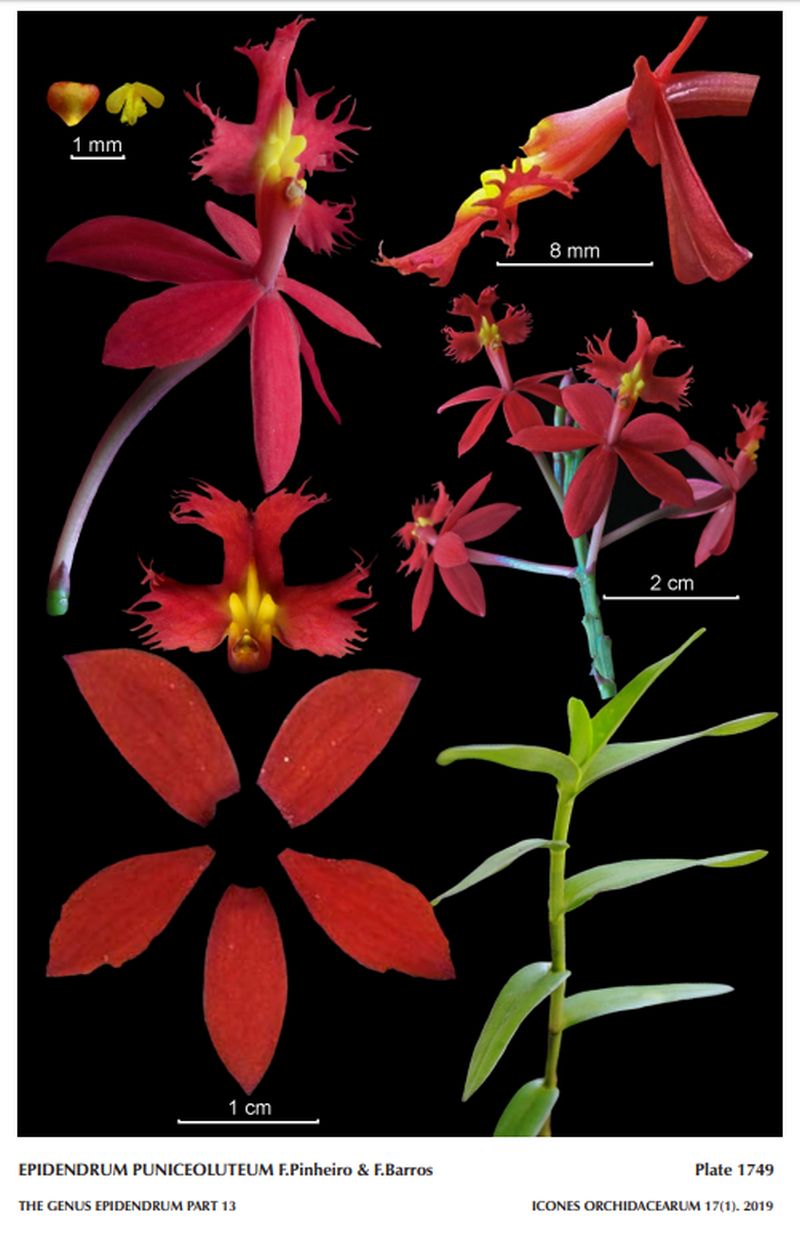

Epidendrum puniceoluteum F.Pinheiro & F.Barros 2006 GROUP Secundum SUBGROUP Secundum
LCDP Photo by © L. F. Varella & A. Cisneros / Photo by © L. F. Varella and The AMO Herbario Website



Common Name The Crimson and Yellow Epidendrum
Flower Size 1" [2.5 cm]
Found in Parana, Rio Grande del Sol and Sao Paulo states of Brazil in restinga vegetation, both among grasses in open formations, such as in small forests, growing amid and supported by bushes and small trees at elevations near sea level as a small to giant sized, warm to cool growing terrestrial with simple, cane-like, erect stems carrying distichous, long-lanceolate to oblong-lanceolate, acute leaves that blooms in the summer on an apical, simple, terete, straight, carrying 11 to 16, distributed all along the stem; sheaths tubular, slightly laterally compress, thin, smooth, chartaceous, scarious when dry, green; blade oblong-lanceolate, apex retuse, coriaceous, green, margin entire leaves that blooms in the on a terminal, sometimes branched, peduncle 10.4 to 11.2" [26 to 28 cm] long, elongate, terete, straight, green, covered by chartaceous, striated, scarious when dry, gray, imbricated, acuminate tubular bracts, peduncle longer than the rachis, enveloped mostly by elongate sheaths, bracteate above, 8.4 to 20.8" [21 to 52 cm] long overall, apical from the mature stem, simple to pluri-racemose, erect, producing 1 to 3 new racemes from the upper nodes of the peduncle, rachis shorter, in a corymb, successively 3 to 8, 6 to 17 flowered inflorescence with decreasing, much shorter than the ovary, triangular, chartaceous, acuminate, embracing floralFlowers successive, to 6 to 8 open at a time, with floral buds in various stages of development, non-resupinate, bright red, apical lobes of the lip, calli and mid-rib of the lip yellow, the color spilling onto the disc of the lip and apex of column, anther green; fragrance none.
"Epidendrum puniceoluteum belongs to the GROUP Secundum SUBGROUP Secundum which is characterized by the caespitose habit, erect, simple, cane-like stems, a normally elongate peduncle of the inflorescence, an erect raceme of generally resupinate, showy, colorful flowers, and a lip adorned by two calli and a median narrow keel. This species, from the southern coast of Brazil, is recognized by the non-resupinate, bright red flowers with yellow calli and mid-rib; sepals .44 to .72" [11 to 18 mm] long, petals elliptic, relatively wide; the deeply 3-lobed lip; the calli linguiform, ascendant, slightly divergent, low, with a prominent mid-rib, laminar, reaching the middle of the isthmus of the mid-lobe; lateral lobes sub-quadrate to sub-flabelliform, posterior margin entire, distal margins deeply laciniate; mid-lobe formed by sub-oblong isthmus in the basal half, apical half bilobed, the lobes divergent, sub-quadrate, the distal margin laciniate. Epidendrum x obrienianum Rolfe being the similar color and overall shape, is distinguished mainly by the narrower, oblong petals, and especially by the calli being wide, linguiform, sub-divergent, ascendant. Epidendrum cryptopateras Hágsater & Courtinard, from Martinique, being the same color and overall shape but having slightly shorter sepals and petals (about 13 mm long), is distinguished mainly by the calli which are narrow, laminar, parallel, erect, semi-elliptic." Hagsater etal 2019
Synonyms
References W3 Tropicos, Kew Monocot list , IPNI ; *Hoehnea 33(2): 247-250, 2 fig., F.Pinheiro & F.Barros 2006 Icones Orchidacearum 17(1) Plate 1715 Hagsater & Jimenez 2019 see recognintion section; Icones Orchidacearum 17(1) Plate 1745 Hagsater & Jimenez 2019 see recognition section; Icones Orchidacearum 17(1) Plate 1749 Hagsater & Jimenez 2019 LCDP Photo/photo fide;
--------------------------------------------------------------------------------------------------------------------------